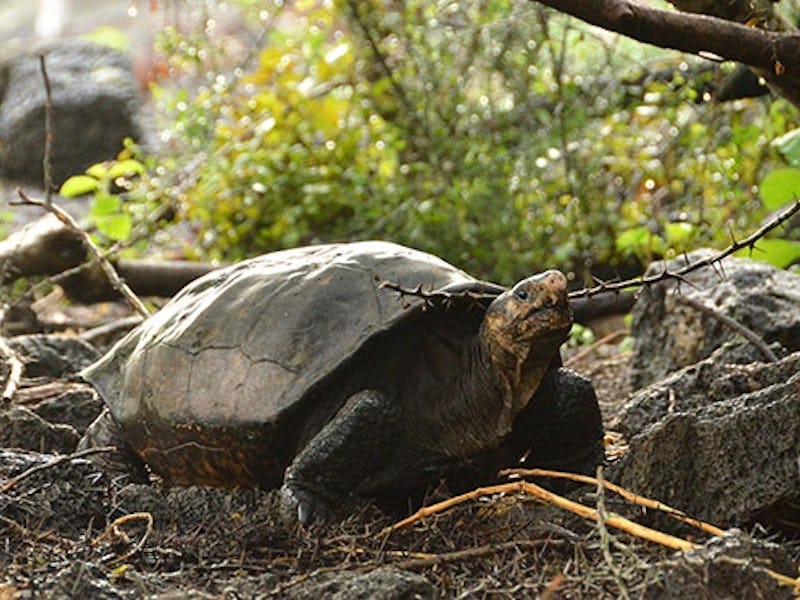How 3 Extinct Species Returned From the Dead
Extinct until proven living.

Like something out of a zombie movie, species that were once thought extinct seem to be rising from the dead. Between February 21 and March 4 2019, three notable rediscoveries were announced — the Fernandina Island Galápagos tortoise (Chelonoidis phantasticus), which was last seen in 1906; Wallace’s giant bee (Megachile pluto), which had supposedly disappeared in 1980; and the Formosan clouded leopard (Neofelis nebulosa brachyura), which disappeared after the last sighting in 1983 and was officially declared extinct in 2013.
See also: Ancient Giant Sloth Bones Reveal the Unexpected Culprits in Their Extinction
These rediscoveries suggest we may know very little about some of the world’s rarest species, but they also raise the question of how species are declared extinct in the first place. The IUCN Red List collates a global register of threatened species and measures their relative risks of extinction. The Red List has a set of criteria to determine the threat status of a species, which are only listed as “Extinct” when…
… there is no reasonable doubt that the last individual has died.
According to the Red List, this requires…
… exhaustive surveys in known and/or expected habitat, at appropriate times… throughout its historic range [which] have failed to record an individual. Surveys should be over a time frame appropriate to the taxon’s life cycle and life form.
Given all the evidence — or rather, lack of evidence — that’s needed, it’s surprising that any species is ever declared extinct. The criteria show that to understand whether a species is extinct, we need to know what it was doing in the past.
The world’s largest bee was presumed extinct before rediscovery in Indonesia in February 2019.
Sightings at a certain time and in a certain place make up our knowledge of a species’ survival, but when a species becomes rare, sightings are increasingly infrequent so that people start to wonder whether the species still exists.
People often use the time since the last sighting as a measure of likelihood when deciding if a species has died out, but the last sighting is rarely the last individual of the species or the actual date of extinction.
Instead, the species may persist for years without being seen, but the length of time since the last sighting strongly influences assumptions as to whether a species has gone extinct or not.
But what is a sighting? It can come in a variety of forms, from direct observation of a live individual in the flesh or in photographs, indirect evidence such as foot prints, scratches and feces, and oral accounts from interviews with eyewitnesses.
But these different lines of evidence aren’t all worth the same — a bird in the hand is worth more than a roomful of recollections from people who saw it in the past. Trying to determine what are true sightings and what are false complicates the declaration of extinction.
The Formosan clouded leopard is endemic to Taiwan and considered extinct, but eyewitness accounts keep speculation alive.
The idea of a species being “rediscovered” can confuse things further. Rediscovery implies that something was lost or forgotten but the term often gives the impression that a species has returned from the dead — hence the term “lazarus species”. This misinterpretation of lost or forgotten species means the default assumption is extinction for any species that hasn’t been seen for a number of years.
So, what does this mean for the three recently “rediscovered” species?
While a living specimen of the Fernandina Island Galápagos tortoise had not been seen since 1906, indirect observations of tortoise feces, footprints, and tortoise-like bite marks out of prickly pear cacti had been made as recently as 2013.
The uncertainty around the quality of these later observations and the long time since the last living sighting probably contributed to it being declared “Critically Endangered (Possibly Extinct)” in 2015. In the natural world, a species is presumed extinct until proven living.
Thought to be the last of its kind, this Fernandina Island Galápagos tortoise specimen was collected in 1906.
Wallace’s giant bee may not have been recorded in the last 38 years, but it was never actually declared extinct according to the IUCN Red List. In fact, for many years it languished under the criteria of Data Deficient and was only recently assessed as Vulnerable.
So, while this is an exciting find for something that hadn’t been seen for so long, its rediscovery shows how little is known about many rare species in the wild, rather than how scarce they are.
See also: Having Big Genitals Can Spell Evolutionary Disaster, Say Paleobiologists
The Formosan clouded leopard, meanwhile, was actually listed as Extinct. The last sighting of the species was in 1983, based on interviews with 70 hunters, and extensive camera trapping during the 2000s failed to detect its presence. It was officially declared extinct in 2013.
While the giant tortoise and bee were proclaimed alive after living specimens were found, the clouded leopard’s rediscovery is more uncertain. Based on sightings on two separate occasions by two sets of wildlife rangers, the evidence is compelling. But whether the Formosan Clouded Leopard has really risen from the dead will require considerably more effort to prove.
This article was originally published on The Conversation by David Roberts. Read the original article here.